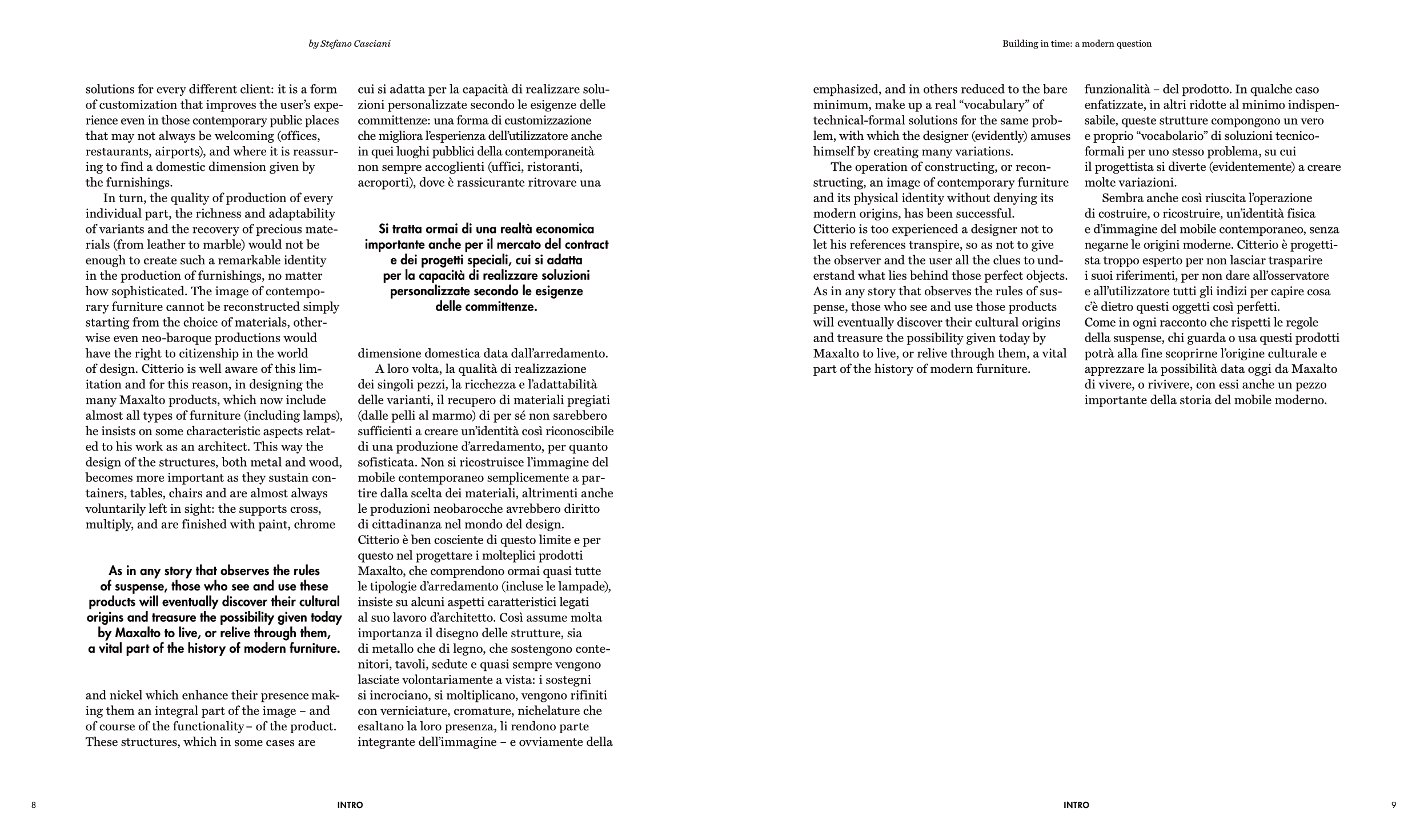9
8
INTRO
INTRO
As in any story that observes the rules
of suspense, those who see and use these
products will eventually discover their cultural
origins and treasure the possibility given today
by Maxalto to live, or relive through them,
a vital part of the history of modern furniture.
Si tratta ormai di una realtà economica
importante anche per il mercato del contract
e dei progetti speciali, cui si adatta
per la capacità di realizzare soluzioni
personalizzate secondo le esigenze
delle committenze.
solutions for every different client: it is a form
of customization that improves the user’s expe-
rience even in those contemporary public places
that may not always be welcoming (offices,
restaurants, airports), and where it is reassur-
ing to find a domestic dimension given by
the furnishings.
In turn, the quality of production of every
individual part, the richness and adaptability
of variants and the recovery of precious mate-
rials (from leather to marble) would not be
enough to create such a remarkable identity
in the production of furnishings, no matter
how sophisticated. The image of contempo-
rary furniture cannot be reconstructed simply
starting from the choice of materials, other-
wise even neo-baroque productions would
have the right to citizenship in the world
of design. Citterio is well aware of this lim-
itation and for this reason, in designing the
many Maxalto products, which now include
almost all types of furniture (including lamps),
he insists on some characteristic aspects relat-
ed to his work as an architect. This way the
design of the structures, both metal and wood,
becomes more important as they sustain con-
tainers, tables, chairs and are almost always
voluntarily left in sight: the supports cross,
multiply, and are finished with paint, chrome
and nickel which enhance their presence mak-
ing them an integral part of the image – and
of course of the functionality – of the product.
These structures, which in some cases are
emphasized, and in others reduced to the bare
minimum, make up a real “vocabulary” of
technical-formal solutions for the same prob-
lem, with which the designer (evidently) amuses
himself by creating many variations.
The operation of constructing, or recon-
structing, an image of contemporary furniture
and its physical identity without denying its
modern origins, has been successful.
Citterio is too experienced a designer not to
let his references transpire, so as not to give
the observer and the user all the clues to und-
erstand what lies behind those perfect objects.
As in any story that observes the rules of sus-
pense, those who see and use those products
will eventually discover their cultural origins
and treasure the possibility given today by
Maxalto to live, or relive through them, a vital
part of the history of modern furniture.
cui si adatta per la capacità di realizzare solu-
zioni personalizzate secondo le esigenze delle
committenze: una forma di customizzazione
che migliora l’esperienza dell’utilizzatore anche
in quei luoghi pubblici della contemporaneità
non sempre accoglienti (uffici, ristoranti,
aeroporti), dove è rassicurante ritrovare una
dimensione domestica data dall’arredamento.
A loro volta, la qualità di realizzazione
dei singoli pezzi, la ricchezza e l’adattabilità
delle varianti, il recupero di materiali pregiati
(dalle pelli al marmo) di per sé non sarebbero
sufficienti a creare un’identità così riconoscibile
di una produzione d’arredamento, per quanto
sofisticata. Non si ricostruisce l’immagine del
mobile contemporaneo semplicemente a par-
tire dalla scelta dei materiali, altrimenti anche
le produzioni neobarocche avrebbero diritto
di cittadinanza nel mondo del design.
Citterio è ben cosciente di questo limite e per
questo nel progettare i molteplici prodotti
Maxalto, che comprendono ormai quasi tutte
le tipologie d’arredamento (incluse le lampade),
insiste su alcuni aspetti caratteristici legati
al suo lavoro d’architetto. Così assume molta
importanza il disegno delle strutture, sia
di metallo che di legno, che sostengono conte-
nitori, tavoli, sedute e quasi sempre vengono
lasciate volontariamente a vista: i sostegni
si incrociano, si moltiplicano, vengono rifiniti
con verniciature, cromature, nichelature che
esaltano la loro presenza, li rendono parte
integrante dell’immagine – e ovviamente della
funzionalità – del prodotto. In qualche caso
enfatizzate, in altri ridotte al minimo indispen-
sabile, queste strutture compongono un vero
e proprio “vocabolario” di soluzioni tecnico-
formali per uno stesso problema, su cui
il progettista si diverte (evidentemente) a creare
molte variazioni.
Sembra anche così riuscita l’operazione
di costruire, o ricostruire, un’identità fisica
e d’immagine del mobile contemporaneo, senza
negarne le origini moderne. Citterio è progetti-
sta troppo esperto per non lasciar trasparire
i suoi riferimenti, per non dare all’osservatore
e all’utilizzatore tutti gli indizi per capire cosa
c’è dietro questi oggetti così perfetti.
Come in ogni racconto che rispetti le regole
della suspense, chi guarda o usa questi prodotti
potrà alla fine scoprirne l’origine culturale e
apprezzare la possibilità data oggi da Maxalto
di vivere, o rivivere, con essi anche un pezzo
importante della storia del mobile moderno.
Building in time: a modern question
by Stefano Casciani


